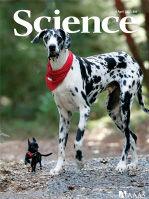Dogs Are Shedding... Light on Human Health

Photo: Maggie Bartlett, NHGRI
At the recent Anita Roberts Lecture, Elaine Ostrander described how her research on dog genetics is shedding light on canine as well as human development.
Domestic dogs (Canis familiaris), which diverged from the gray wolf (Canis lupus) more than 15,000 years ago, have become a scientist’s best friend thanks to the work of NHGRI senior investigator Elaine Ostrander and her colleagues.
At the April 29 Anita Roberts lecture, Ostrander described her work studying genes that control the morphology of some of the approximately 400 dog breeds in the world. Dogs are useful for genetic studies because selective mating has generated a diverse range of breeds that are defined by specific morphological characteristics. Scientists are able to identify genes responsible for various traits—body size, fur, leg length, skull shape, leg width, back arch, tail curl, and ear position—as well as resistance or susceptibility to cancer and other diseases.
“Each breed represents a genetically isolated population, much like the Icelandic families in human genetics,” explained Ostrander, chief of NHGRI’s Cancer Genetics Branch. “We can take advantage of breed structure in order to amplify the underlying genetics for some of the traits that we are really interested in for both human and dog health and biology.”
Ostrander’s lab conducts genome-wide association studies (GWAS) to examine the DNA of hundreds of dogs of various breeds, maps genes, and looks for correlations between gene markers and traits. A common ancestral mutation may be responsible for the same traits in different breeds.

The cover of the April 7, 2007, edition of Science featured a Chihuahua and a Great Dane to highlight Ostrander’s and Sutter’s work on the genetic determinants of size diversity in dogs.
As a postdoc in Ostrander’s lab, Nate Sutter studied the genetics of the Portuguese Water Dog. He identified a region on chromosome 15 that correlated with body size and determined that a single allele of the gene IGF-1 is found in all small breeds. This gene is nearly absent from giant breeds. IGF-1 is also known to influence body size in mice and humans. (Sutter is now an assistant professor at Cornell’s College of Veterinary Medicine in Ithaca, N.Y.)
Graduate student Edouard Cadieu, who is back at the University of Rennes in France, showed that variants of three genes account for almost all of the coat phenotypes of different dog breeds: KRT71 is responsible for the curliness of a coat, FGF5 for its length, and RSPO2 for the furnishings (moustache and eyebrows). In addition, staff scientist Heidi Parker determined that the insertion of the FGF4 retrogene is responsible for chondrodysplasia (asymmetric dwarfism), the short-legged phenotype seen in breeds such as the Basset Hound.
Recently, Ostrander and postdoc Jeff Schoenebeck began tackling the genetics of canine skull shape. Ostrander expects to find that multiple genes are involved. So far, one of the BMP genes has been identified as a major player in snout development; mutations in the gene are associated with brachycephaly (shortened snout). In humans, mutations of the same gene result in syndromes with similar disruptions in facial development.
Understanding canine genetics provides a good model for understanding human development. Ostrander is certainly leading the pack in this endeavor.
Anita B. Roberts, who spent 30 years at NCI before her death in 2006, was known for her groundbreaking work on transforming growth factor–beta. The “Anita B. Roberts Lecture Series: Distinguished Women Scientists at NIH” honors the research contributions she and other female scientists have made. To see a videocast of Ostrander’s talk or other Roberts lectures, go to https://videocast.nih.gov/PastEvents.asp?c=151.
This page was last updated on Monday, May 2, 2022
